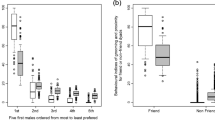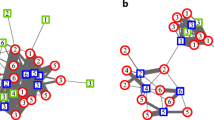Abstract
Mate selection is a proximate mechanism influencing the probability that two individuals will engage in reproductive activity. The degree to which mate selection by female savanna baboons (Papio cynocephalus anubis) affects consortship formation and the characteristics of males that they prefer to mate with were analyzed based upon a 19-month study in Kenya. Sexual solicitations by females had a positive impact on the probability that males would establish consort relationships. The most preferred mating partners were young, high ranking, newcomer males, but these same males did not have the highest mating success. Friendships between male and female baboons almost always developed subsequent to conception cycles. Female savanna baboon reproductive tactics appear to be based upon maximizing the probability that males will provide care for offspring.
Similar content being viewed by others
References
Altmann, J., 1974. Observational study of behavior: Sampling methods.Behaviour, 49: 227–267.
————, 1980.Baboon Mothers and Infants. Harvard Univ. Press, Cambridge.
————,G. Hausfater, &S. A. Altmann, 1988. Determinants of reproductive success in savannah baboons,Papio cynocephalus. In:Reproductive Success,T. H. Clutton-Brock (ed.), Univ. of Chicago Press, Chicago, pp. 403–418.
Altmann, S. A. &J. Altmann, 1979. Demographic constraints on behavior and social organzation. In:Primate Ecology and Human Origins,I. Bernstein &E. O. Smith (eds.), Garland, New York, pp. 47–64.
Anderson, C. M., 1983. Levels of social organization and male-female bonding in the genusPapio.Amer. J. Phys. Anthropol, 60: 15–22.
Bateson, P., 1983. Optimal outbreeding. In:Mate Choice,P. Bateson (ed.), Cambridge Univ. Press, Cambridge, pp. 257–277.
Beach, F. A., 1976. Sexual attractivity, proceptivity, and receptivity in female mammals.Horm. Behav., 7: 105–138.
Bercovitch, F. B., 1978. Mate selection and sexual selection in nonhuman primates.Calif. Anthropol, 8: 9–12.
————, 1983. Time budgets and consortships in olive baboons (Papio anubis).Folia Primatol., 41: 180–190.
————, 1985. Reproductive tactics in adult female and adult male olive baboons. Ph.D. thesis, Univ. of California, Los Angeles.
————, 1986. Male rank and reproductive activity in savanna baboons.Int. J. Primatol., 7: 533–550.
————, 1987a. Female weight and reproductive condition in a population of olive baboons (Papio anubis).Amer. J. Primatol., 12: 189–195.
————, 1987b. Reproductive success in male savanna baboons.Behav. Ecol. Sociobiol., 21: 163–172.
————, 1988. Coalitions, cooperation and reproductive tactics among adult male baboons.Anim. Behav., 36: 1198–1209.
————, 1989. Body size, sperm competition, and determinants of reproductive success in male savanna baboons.Evolution, 43: 1507–1521.
----, 1990. Female choice, male reproductive success, and the origin of one male groups in baboons. In:Baboons: Behaviour and Ecology, Use and Care,M. Thiago de Mello, A. Whiten, & R. W. Byrne (eds.), Brasilia, Brazil, pp. 61–76.
----,S. C. Strum, & R. S. O. Harding, 1991. Female reproductive strategies and annual birth patterns over a ten year period at Gilgil, Kenya. Submitted.
Blankenship, L. &S. Qvortrup, 1974. Resource management on a Kenya ranch.J. S. Afr. Wildl. Manag. Assoc., 4: 185–190.
Busse, C. &W. J. Hamilton, III, 1981. Infant carrying by male chacma baboons.Science, 212: 1281–1283.
Byles, R. H., M. F. Sanders, G. M. Petersen, T. J. Olivier, F. B. Bercovitch, &E. Hunt. 1980. A-B-O blood groups in Kenya olive baboons (Papio anubis).Anim. Blood Grps. Biochem. Genet., 11: 245–249.
Chapais, B., 1986. Why do adult male and female rhesus monkeys affiliate during the birth season? In:The Cayo Santiago Macaques,R. G. Rawlins &M. J. Kessler (eds.). SUNY Press, Albany, pp. 173–200.
Collins, D. A., 1981. Social behaviour and patterns of mating among adult yellow baboons (Papio c. cynocephalus L. 1776). Ph.D. thesis, Univ. of Edinburgh, Edinburgh.
————, 1986. Interactions between adult male and infant yellow baboons (Papio c. cynocephalus) in Tanzania.Anim. Behav., 34: 430–443.
Cords, M., 1987. Forest guenons and patas monkeys: male-male competition in one-male groups. In:Primate Societies,B. B. Smuts,D. L. Cheney,R. M. Seyfarth,R. W. Wrangham, &T. T. Struhsaker (eds.), Univ. of Chicago Press, Chicago, pp. 98–111.
Cox, C. R. &B. J. Le Boeuf, 1977. Female incitation of male competition: a mechanism in sexual selection.Amer. Naturalist, 111: 317–335.
DeVore, I., 1963. Mother-infant relations in free-ranging baboons. In:Maternal Behavior in Mammals,H. L. Rheingold (ed.), John Wiley & Sons, New York, pp. 305–335.
Dunbar, R. I. M., 1979. Population demography, social organisation and mating strategies. In:Primate Ecology and Human Origins,I. Bernstein &E. O. Smith (eds.), Garland, New York, pp. 65–88.
————, 1984.Reproductive Decisions. Princeton Univ. Press, Princeton.
Epple, G. &M. C. Alveario, 1986. Female choice and male fertility influence pair bonding in tamarins (Saguinus fuscicollis).Prim. Rep., 14: 76.
Gillman, J. &C. Gilbert, 1946. The reproductive cycle of the chacma baboon (Papio ursinus) with special reference to the problems of menstrual irregularities as assessed by the behaviour of the sex skin.S. Afr. J. Med. Sci., Suppl., 11: 1–54.
Halliday, T. R., 1983. The study of mate choice. In:Mate Choice,P. Bateson (ed.), Cambridge Univ. Press, Cambridge, pp. 3–32.
Harding, R. S. O., 1976. Ranging patterns of a troop of baboons (Papio anubis) in Kenya.Folia Primatol., 25: 143–185.
Hausfater, G., 1975.Dominance and Reproduction in Baboons (Papio cynocephalus):A Quantitative Analysis. Contributions to Primatology, Vol. 7, S. Karger, Basel.
———— &D. Takacs, 1987. Structure and function of hindquarter presentations in yellow baboons (Papio cynocephalus).Ethology, 74: 297–319.
Hendrickx, A. G. &D. C. Kraemer, 1969. Observations on the menstrual cycle, optimal mating time and pre-implantation embryos of the baboon,Papio anubis andPapio cynocephalus.J. Reprod. Fert., Suppl., 6: 119–128.
———— & ————, 1971. Reproduction, In:Embryology of the Baboon,A. G. Hendrickx (ed.), Univ. of Chicago Press, Chicago, pp. 3–30.
Hill, D. A., 1986. Social relationships between adult male and immature rhesus macaques.Primates, 27: 425–440.
Huffman, M. A., 1986. Mate choice and partner preference in female Japanese macaques.Prim. Rep., 14: 110.
————, 1991. Mate selection and partner preferences in female Japanese macaques. In:The Monkeys of Arashiyama,L. M. Fedigan &P. J. Asquith (eds.), SUNY Press, Albany, pp. 101–122.
Janson, C. H., 1984. Female choice and mating system of the brown capuchin monkeyCebus apella.Z. Tierpsychol., 65: 177–200.
Johnson, J. A., 1984. Social relationships of juvenile olive baboons. Ph.D. thesis, Univ. of Edinburgh, Edinburgh.
Jones, C. B., 1985. Reproductive patterns in mantled howler monkeys: estrus, mate choice and copulation.Primates, 26: 130–142.
Keddy, A. C., 1986. Female mate choice in vervet monkeys (Cercopithecus aethiops sabaeus).Amer. J. Primatol., 10: 125–134.
Manzolillo, D. L., 1982. Intertroop transfer by adult malePapio anubis. Ph.D. thesis, Univ. of California, Los Angeles.
Maynard Smith, J., 1975.The Theory of Evolution (3rd. ed.). Penguin Books, London.
Milton, K., 1985. Mating patterns of woolly spider monkeys,Brachyteles arachnoides: implications for female choice.Behav. Ecol. Sociobiol., 17: 53–59.
Moore, J. &R. Ali, 1984. Are dispersal and inbreeding avoidance related?Anim. Behav., 32: 94–112.
Nicolson, N. A., 1982. Weaning and the development of independence in olive baboons. Ph.D. thesis, Harvard Univ., Cambridge, Massachusetts.
Packer, C., 1979. Inter-troop transfer and inbreeding avoidance inPapio anubis.Anim. Behav., 27: 1–36.
————, 1980. Male care and exploitation of infants inPapio anubis.Anim. Behav., 28: 512–520.
————, 1985. Dispersal and inbreeding avoidance.Anim. Behav., 33: 676–678.
Popp, J. L., 1978. Male baboons and evolutionary principles. Ph.D. thesis, Harvard Univ., Cambridge, Massachusetts.
————, 1983. Ecological determinism in the life histories of baboons.Primates, 24: 198–210.
Ransom, T. W., 1981.Beach Troop of the Gombe. Bucknell Univ. Press, Lewisburg.
———— &B. S. Ransom, 1971. Adult male-infant relations among baboons (Papio anubis).Folia Primatol., 16: 179–195.
Rasmussen, K. L. R., 1980. Consort behaviour and mate selection in yellow baboons (Papio cynocephalus). Ph.D. thesis, Cambridge Univ., Cambridge.
————, 1983a. Age-related variation in the interactions of adult females with adult males in yellow baboons. In:Primate Social Relationships,R. A. Hinde (ed.), Blackwell Scientific Publ., Oxford, pp. 47–53.
————, 1983b. Influence of affiliative preferences upon the behaviour of male and female baboons during sexual consortships. In:Primate Social Relationships,R. A. Hinde (ed.), Blackwell Scientific Publ., Oxford, pp. 116–120.
Rowell, T. E., 1967. Female reproductive cycles and the behavior of baboons and rhesus macaques. In:Social Communication Among Primates,S. A. Altmann (ed.), Univ. of Chicago Press, Chicago, pp. 15–32.
Schurmann, C. L. &J. A. R. A. M. van Hooff, 1986. Reproductive strategies of the orang-utan: new data and a reconsideration of existing sociosexual models.Int. J. Primatol., 7: 265–287.
Scott, L. M., 1984. Reproductive behavior of adolescent female baboons (Papio anubis) in Kenya. In:Female Primates Studies by Women Primatologists,M. F. Small (ed.), Alan R. Liss, New York, pp. 77–100.
Seyfarth, R. M., 1978a. Social relationships among adult male and female baboons. I. Behaviour during sexual consortship.Behaviour, 64: 204–226.
————, 1978b. Social relationships among adult male and female baboons. II. Behaviour throughout the female reproductive cycle.Behaviour, 64: 227–247.
Siegel, S., 1956.Nonparametric Statistics for the Behavioral Sciences McGraw-Hill, New York.
Small, M. F., 1989. Female choice in nonhuman primates.Yrbk. Phys. Anthropol, 32: 103–127.
Smith, E. O. &P. L. Whitten, 1988. Triadic interactions in savanna-dwelling baboons.Int. J. Primatol., 9: 409–424.
Smuts, B., 1982. Special relationships between adult male and female olive baboons (Papio anubis). Ph.D. thesis, Stanford Univ., Stanford.
————, 1983. Special relationships between adult male and female olive baboons: selective advantages. In:Primate Social Relationships,R. A. Hinde (ed.), Blackwell Scientific Publ., Oxford, pp. 262–266.
————, 1985.Sex and Friendship in baboons. Aldine, New York.
————, 1987. Sexual competition and mate choice. In:Primate Societies,B. B. Smuts,D. L. Cheney,R. M. Seyfarth,R. W. Wrangham, &T. T. Struhsaker (eds.), Univ. of Chicago Press, Chicago, pp. 385–399.
Sokal, R. R. &F. J. Rohlf, 1981.Biometry, W. H. Freeman, San Francisco.
Stein, D. M., 1984a. Ontogeny of infant-adult male relationships during the first year of life for yellow baboons (Papio cynocephalus). In:Primate Paternalism,D. M. Taub (ed.), Van Nostrand Reinhold, New York, pp. 213–243.
————, 1984b.The Sociobiology of Infant and Adult Male Baboons. Ablex Publ. Co., Norwood, New Jersey.
———— &P. B. Stacey, 1981. A comparison of infant-adult male relations in a one-male group with those in a multi-male group for yellow baboons (Papio cynocephalus).Folia Primatol., 36: 264–276.
Strum, S. C., 1982. Agonistic dominance in male baboons: an alternative view.Int. J. Primatol., 3: 175–202.
————, 1984. Why males use infants. In:Primate Paternalism,D. M. Taub (ed.), Van Nostrand Reinhold, New York, pp. 146–185.
————, 1987.Almost Human. Random House, New York.
Takahata, Y., 1982. Social relations between adult males and females of Japanese monkeys in the Arashiyama B troop.Primates, 23: 1–23.
Taub, D. M., 1980. Female choice and mating strategies among wild Barbary macaques (Macaca sylvanus L.). In:The Macaques Studies in Ecology, Behavior and Evolution,D. G. Lindburg (ed.), Van Nostrand Reinhold, New York, pp. 287–344.
Taylor, H., J. Teas, T. Richie, C. Southwick, &R. Shrestha, 1978. Social interactions between adult male and infant rhesus monkeys in Nepal.Primates, 19: 343–351.
Tutin, C. E. G., 1979. Mating patterns and reproductive strategies in a community of wild chimpanzees (Pan troglodytes schweinfurthii).Behav. Ecol. Sociobiol., 6: 29–38.
Wickler, W., 1967. Socio-sexual signals and their intra-specific imitation among primates. In:Primate Ethology,D. Morris (ed.), Doubleday, New York, pp. 89–189.
Zar, J. H., 1974.Biostatistical Analysis. Prentice-Hall, Englewood Cliffs, New Jersey.
Zuckerman, S., 1930. The menstrual cycle of the primates. Part I. General nature and homology.Proc. Zool. Soc., Lond., 1930: 691–754.
Zumpe, D. &R. P. Michael. 1987. Relation between the dominance rank of female rhesus monkeys and their access to males.Amer. J. Primatol., 13: 155–169.
Author information
Authors and Affiliations
About this article
Cite this article
Bercovitch, F.B. Mate selection, consortship formation, and reproductive tactics in adult female savanna baboons. Primates 32, 437–452 (1991). https://doi.org/10.1007/BF02381935
Received:
Accepted:
Issue Date:
DOI: https://doi.org/10.1007/BF02381935




